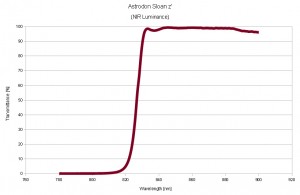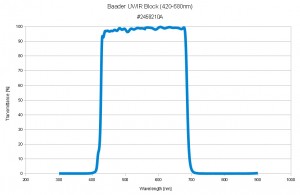Seeing is believing. I like to check and measure myself various characteristics and parameters of new items that I have just purchased. The purpose is to show how good or bad the product is in order to make it easier for other astrophotographers (I usually buy only photography stuff) to make the purchase decision. This time, I got another chance to use the Carl Zeiss Jena SPECORD M400 spectrophotometer so I took the filters I haven’t measured yet and did a full spectrum run.
First, let’s see IDAS LPS-P2, the highly recommended and popular filter (almost a must have for one-shot-color cameras) to fight against light pollution. Personally, I call this filter a “soft-LPS” (or soft-CLS) and I use it at locations with only slight light pollution (e.g. in a National Park or simply at the best dark sky locations I usually shoot at). LP is unfortunately everywhere (in my case). The best on this filter is that it allows for good color calibration. It doesn’t eat that much of yellow-red colors like a typical CLS filter does (see below). The downside is that it works best in dark sky locations and is not very strong in the fight against light pollution.
The measured chart (above) of an IDAS LPS-P2 perfectly matches manufacturer’s chart so it really delivers what it advertises (as in fact all of these filters, this time).
Next, let’s see IDAS LPS-V4. Personally, I call this filter “OSC-narrowband” as it blocks everything except of a “narrower” bandpass around OIII (500nm) and around Hydrogen Alpha (656nm) so it is useful to capture this kind of signal in one shot which, in case of an OSC camera, makes use of all RGGB Bayer color planes (unlike of e.g. pure H-a filter that when used with OSC CCD renders green and blue color planes useless – as they contain only noise).
The only thing I do not like on this filter (I am very demanding customer) is that there’s a bit of leak (topping 25% of transmittance at around 377nm) in UV part of the spectrum – this is not very good for cases when you use poorly corrected optics in UV (almost every objective lens – refracting optics – has this kind of “issue”). On the other hand, it matches manufacturer’s plot so there’s no intention to hide this subtle imperfection. If I am a filter manufacturer I’d make a filter similar to this one but with no UV leak and with even much narrower pass at the OIII and Ha emission lines (Ha with NII and maybe also with SII lines) that would serve very well for “narrowband Luminance channel” ![]() Just my sci-fi vision (I’ve got plenty of such stupid ideas).
Just my sci-fi vision (I’ve got plenty of such stupid ideas).
Next is Astrodon Sloan z’ filter that I purchased for some experiments in infrared shooting (I use it as IR-Luminance – actually I have used it only once). This filter should block visible light and pass signal starting from 820nm of wavelength. My test proves it is really a digital filter passing 0.07% of visible light and around 821nm it takes off (with 7.1% of transmittance) over 55.5% of transmittance at 827nm and 98.6% at 833nm. There is no leak anywhere in 200-900nm.
Last filter I tested was Baader UV/IR Block (should block everything but 420-680nm), #2459210A. This one also performs very well and it is one of two Baader filters I like very much (I do not like the rest though (for many reasons) – not talking about Astronomik filters that I do not like all of them (again, for many reasons)). This filter has really great transmittance of 97% to 99% and is currently the only UV/IR solution for refractors where we do really want to cut the UV part (below 400nm) as many refracting optics is poorly corrected in blue. It gets even worse with top-notch / perfect-most filters on the planet Earth – Astrodon filters – in conjunction with a very sensitive CCD camera, where the Blue filter takes off quite early in UV part and has very high transmittance (97-99%) right away – this is very OK and perfect for reflecting optics, but not for refractors – maybe should Astrodon offer two kinds (sets) of Blue filters (the Blue ones are in fact equal for both E-series (Sony ICX, Kodak KAF detectors) and I-series (Kodak KAI detectors) – I do own both sets).
That’s it ![]() .
.




